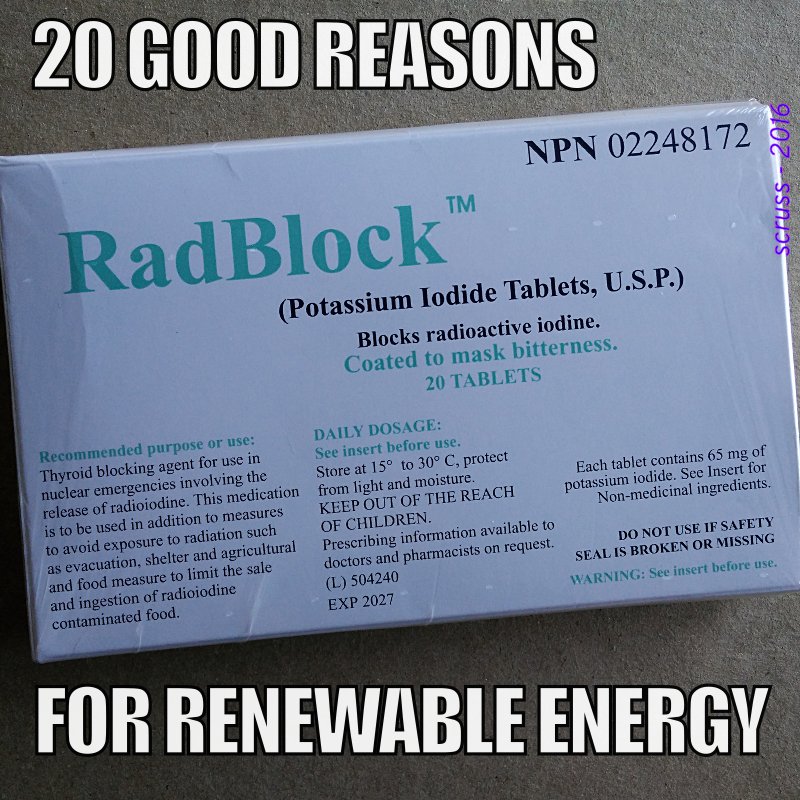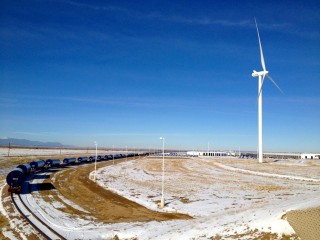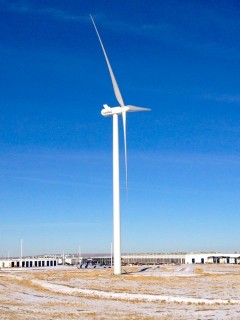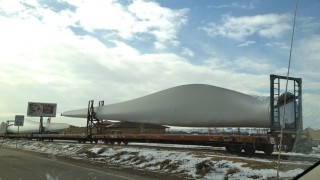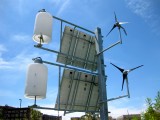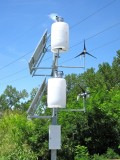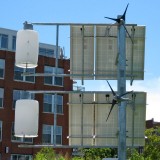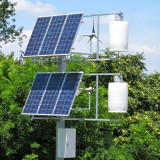You can get these from preparetobesafe.ca.
Category: Wind Things
q absolves data sins and makes CSV queries easy
The cryptically-named q (it also bills itself as being able to “Run SQL directly on CSV files | Text as Dataâ€) is very nifty indeed. It allows you to run SQL queries on delimited text files. It seems to support the full SQLite SQL dialect, too.
I used to frequently query the IESO‘s Hourly Wind Generator Output report (which now hides behind a JS link to obscure the source URL, http://www.ieso.ca//imoweb/pubs/marketReports/download/HourlyWindFarmGen_20160122.csv). Now that the file has nearly 10 years of hourly data and many (but not all) wind projects, it may have outlived its usefulness. But it does allow me to show off some mad SQLite skills …
The first problem is that the file uses nasty date formats. Today would be 23-Jan-16 in the report’s Date field, which is filled with the ugh. You can fix that, though, with a fragment of SQL modified from here:
printf("%4d-%02d-%02d", substr(Date, 8,2)+2000, (instr("---JanFebMarAprMayJunJulAugSepOctNovDec", substr(Date, 4,3))-1)/3, substr(Date, 1, 2)) as isodate
The above data definition sets the isodate column to be in the familiar and useful YYYY-MM-DD ISO format.
A related example would be to query the whole CSV file for monthly mean generation from Kingsbridge and K2 Wind projects (they’re next to one another) for months after K2’s commissioning in March 2015. Here’s what I did in q:
q -T -O -H -d, 'select printf("%4d-%02d", substr(Date, 8,2)+2000, (instr("---JanFebMarAprMayJunJulAugSepOctNovDec", substr(Date, 4,3))-1)/3) as isomonth, avg(KINGSBRIDGE) as kavg, avg(K2WIND) as k2avg from Downloads/HourlyWindFarmGen_20160122.csv where isomonth>"2015-03" group by isomonth'
which gave the results:
isomonth   kavg   k2avg 2015-04   12.7277777778   37.4569444444 2015-05   8.94623655914   67.6747311828 2015-06   6.05833333333   66.6847222222 2015-07   3.96370967742   45.372311828 2015-08   6.34811827957   67.436827957 2015-09   7.29027777778   79.7194444444 2015-10   14.5658602151   128.037634409 2015-11   15.9944444444   130.729166667 2015-12   17.6075268817   152.422043011 2016-01   19.6408730159   163.013888889
Neat! (or at least, I think so.)
WindShare: a stellar investment, a gallant icon
Update: now posted on the Friends of Wind Blog: Windshare: A stellar investment, a gallant icon.
I’ve never regretted my investment in WindShare. When I heard about the plan to put a wind turbine at Exhibition Place, I’d been in Canada for less than a month. We didn’t even have a permanent place to live when I put down my $501. I knew, though, that it would be an investment in the future.
Five hundred bucks seemed quite a bit of cash back then, but these days, it’s less than a flight to anywhere. It’s less than a weekend mini-break. It’s a couple of month’s car insurance, or worse, a car maintenance bill which I wouldn’t even grumble over now. No-one ever expects a car to appreciate after you’ve had the shocks redone, so in the same way, I don’t feel bad about my investment in WindShare not having a financial return. It’s had a much more rewarding return than mere money.
Sure, the initial offering indicated that we were supposed to make a reasonable return, what with the deregulation of the Ontario energy market. You don’t remember that? When the Conservative Ernie “Odo†Eves administration deregulated the market back then, you may have blinked and missed it. At the first taste of $100 power, the deregulation was cancelled, because market forces must always take second place in this province to re-electability. Poor Ernie; we almost saw his like again …
WindShare was supposed to have at least two wind turbines, which would have helped the return to members. For $REASONS, the other one didn’t happen: bureaucracy, lack of suitable turbines, fun with the TPA, lack of headroom from the island airport; any/all/some/none of the above can be cited. We were also supposed to export the model to a community-owned wind farm, but that didn’t happen. The province decided that any and all transmission and distribution near the Bruce was off-limits to all but the eponymous power company. So it goes.
Because of my wind power experience in the UK, I handily got on the inaugural board of WindShare. We campaigned for members around the city. We spoke to anyone who wanted to listen. We built the thing because we believed in the statement we were making. We didn’t hide our pride: we put the turbine where it would be seen by millions every day. If we could’ve put it on the lawn at Queen’s Park, we would.
We even sourced as much of the turbine locally as we could. The tower was made in Ajax. The blades were made in Huron Park. If there had been FIT Domestic Content rules back then, we would’ve aced them.
Now, not quite everything went swimmingly. A few weeks after construction, our vendor went bankrupt. A robust service agreement with a vendor is key to a wind project’s success. With the incredible support of WindShare’s partner in the turbine, frequent visits from the former service tech, a great local electrical service company, and hours and hours of work from dedicated volunteer members, we kept the turbine spinning. Try that with a nuclear plant. Actually, on second thoughts, please don’t.
We also had a slightly smaller set of blades than we’d ordered, having been promised longer ones by the now-defunct vendor. This meant we had to derate the turbine a bit more to avoid challenging operational conditions. Every year at CNE time, we’d lose comms to the turbine as one of the carny trucks would inevitably take out the overhead phone line. We fixed that one.
Other problems cropped up, too. The inverter would get a bit warm in summer heat, and go for a siesta. After building an effective cooling system, the inverter chugged along for a few years until it needed to be replaced. It was interesting working in Canadian generation back then; run-of-the-mill European power electronics were seen as weird new-fangled voodoo in Ontario. As we have lots of wind and solar now, IGBTs are no longer a source of IDKs.
Our wind resource wasn’t quite where we thought it might be, either. ExPlace has a lovely clear fetch across the lake, and historical data from the island might’ve indicated that. Who knew that most of the wind would seem to come over from the city, fuelled by the urban heat effect, and turbulent as all-get-out from chasing through the buildings? Well, we do. With ten year’s hindsight and operational data, that is.
So this turbine — little, (sometimes) broken but still good — what did it start? Well, it lead to the idea of community sustainable power in Ontario. It lead to the abolition of coal power in the province (which, if you can remember the acrid yellow goo that passed for air downwind of Lakeview, you’ll appreciate). It lead to the world-leading FIT program, driving the development of Ontario’s wind and solar industries, which as the last election shows have the overwhelming support of the people of Ontario. It also lead, on a personal scale, to my last decade’s employment building this Province’s sustainable energy base.
So when I see the WindShare turbine — whether fleetingly, from a GO train, or at extreme length when stuck on the terminally gridlocked Gardiner Expressway — it still makes me smile. We built an icon. We built careers then unknown to the province. We built hope. And from that, the return on satisfaction is better than any deal you can get on Bay St.
Wind Power, 1940s style
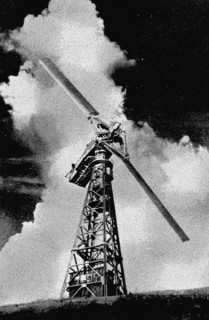 This is how wind turbines were supposed to look, at least in the 1940s. It’s the experimental Smith-Putnam 1.25 MW unit than ran for a short while on a hill near Rutland, VT. The picture’s from a rather falling-apart copy of Large Horizontal-axis Wind Turbines (Thresher, R. W., & Solar Energy Research Institute. (1982). Large horizontal-axis wind turbines: Proceedings of a workshop held in Cleveland, Ohio, July 28-30, 1981. Golden, Colo: Solar Energy Research Institute) that I rescued from Jim‘s recycling years ago.
This is how wind turbines were supposed to look, at least in the 1940s. It’s the experimental Smith-Putnam 1.25 MW unit than ran for a short while on a hill near Rutland, VT. The picture’s from a rather falling-apart copy of Large Horizontal-axis Wind Turbines (Thresher, R. W., & Solar Energy Research Institute. (1982). Large horizontal-axis wind turbines: Proceedings of a workshop held in Cleveland, Ohio, July 28-30, 1981. Golden, Colo: Solar Energy Research Institute) that I rescued from Jim‘s recycling years ago.
The first part of these proceedings has a historical review of the Smith-Putnam turbine, including an excerpt from the S. Morgan Smith Company’s house organ on the project. As the rest of the book is pretty much all about the MOD series of turbines, it’s of less interest. I’ve scanned the bits about the Smith-Putnam turbine, and put them here: NASA_DOE-1981-large_horizontal_axis_wind_turbines-excerpt. If anyone wants the book, let me know. It’s very ratty, but readable.
I’ve written about this turbine before, but in relation to a packet of crayons. More awesome turbine pictures from Paul Gipe: Smith-Putnam Industrial Photos.
New, tall wind turbines are super-awesome, according to REF
If I said that computers got slower with age, you’d look at me as if I were deranged. But REF say effectively that about wind turbines.
My former (nutso) argument goes like this: your 30 year old Commodore 64 is so much slower than the multi-core beastie you’re reading this post on, so computers get slower as they age, amirite …? I can’t actually keep this nonsense up much longer (computers have always been as fast as the market and technology could support), but the Renewable Energy Foundation manage for about 50 pages of statistical gorp in their paper, “Analysis of Wind Farm Performance in UK and Denmark“. And oh boy does the dittosphere like to report on it, like here, here, here, here, and here.
In short, the key graph in the report is this:
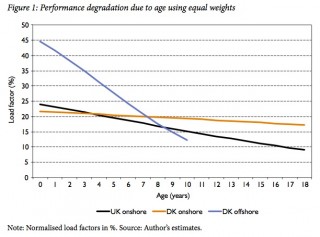 If you believe it, it shows a steady decline in wind farm output with age. But thankfully, the good chaps at REF supply all of their data (and also have a bunch of other wind farm stats lying around in easily scrapeable formats; cheers, m’dears!), so I could take a look at their claims. So I made a subset: uk_annual_ncf [ODF], which has:
If you believe it, it shows a steady decline in wind farm output with age. But thankfully, the good chaps at REF supply all of their data (and also have a bunch of other wind farm stats lying around in easily scrapeable formats; cheers, m’dears!), so I could take a look at their claims. So I made a subset: uk_annual_ncf [ODF], which has:
- all the monthly stats collapsed into annual Net Capacity Factors (NCF) for 2003–2011
- only the sites that have full details of wind turbine model, rating, installation date, height and diameter
- none of the sites that have been obviously repowered, with giant NCF jumps being a giveaway
- minor edits to turbines specs on sites I know and likely worked on at some point.
First off, and most blatantly, there’s no correction for annual wind patterns in the REF report. Blustery Januaries are merrily correlated against balmy Augusts, so there’s a lot of noise in the data. Using only annual data for those sites with 9 full years of data aligned everything quite nicely:
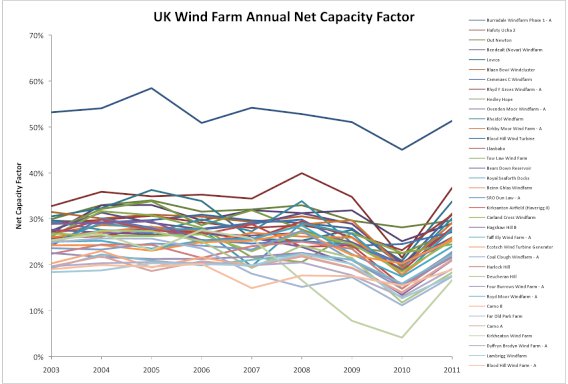 No real trends evident there, except that the wind appeared to have sucked mightily in 2010. So how about if I graph the same data, but plot it by project age at mid-year:
No real trends evident there, except that the wind appeared to have sucked mightily in 2010. So how about if I graph the same data, but plot it by project age at mid-year:
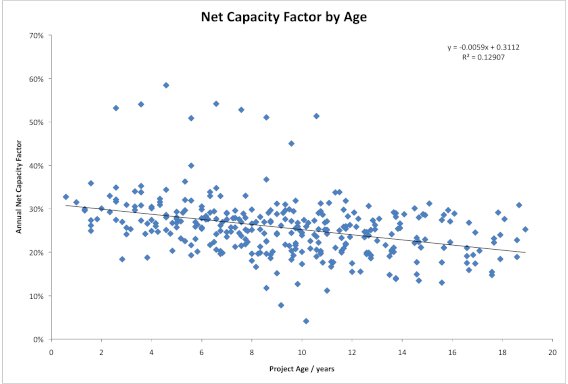 And there it is: a trend pulled from where there was none. It’s not very well correlated, but you could say that it shows a decline in NCF of about 0.6% per year. I wonder where it came from?
And there it is: a trend pulled from where there was none. It’s not very well correlated, but you could say that it shows a decline in NCF of about 0.6% per year. I wonder where it came from?
There’s one site that gives REF’s game away: Blood Hill, in Norfolk. It’s had 10× 225 kW Vestas V27s on 30m towers running since 1992, but it’s also got a single megawatt-class Enercon turbine on a 65 m tower which was installed in 2000. Here’s how the annual capacity factor looks for both sites:
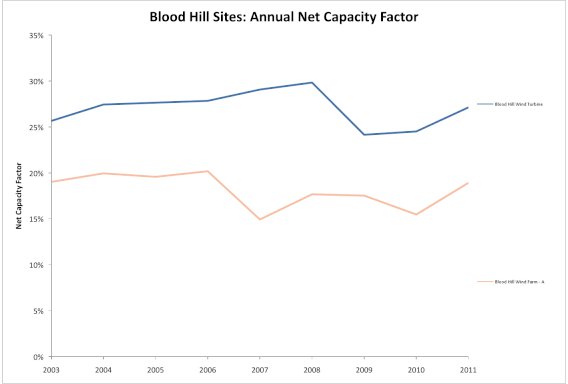 Apart from a slight maintenance wibble in 2007-2008 on the older turbines, the capacity factors track each other quite well. Remember, these turbines are nearly 20 years old at the end of the graph; according to REF, they’d be bumping along at about a third of their original capacity. So let’s graph them by age:
Apart from a slight maintenance wibble in 2007-2008 on the older turbines, the capacity factors track each other quite well. Remember, these turbines are nearly 20 years old at the end of the graph; according to REF, they’d be bumping along at about a third of their original capacity. So let’s graph them by age:
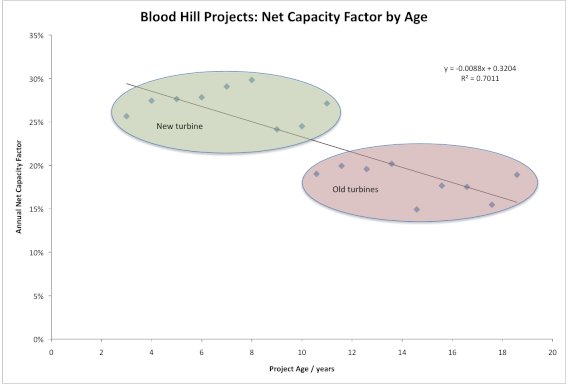 Aha! Here is the secret key (as a certain spider might say). If you compare new, tall turbines against old, small ones you get this false correlation. To show you how much wind turbines have grown, here are the average sizes for each installation year in the data set:
Aha! Here is the secret key (as a certain spider might say). If you compare new, tall turbines against old, small ones you get this false correlation. To show you how much wind turbines have grown, here are the average sizes for each installation year in the data set:
| Year | Avg Height / m |
Avg Diameter / m |
Avg Power / kW |
Installed Capacity in year / MW |
| 1991 | 32.0 | 34.0 | 400.0 | 4.0 |
| 1992 | 30.3 | 31.7 | 343.2 | 25.1 |
| 1993 | 31.8 | 35.2 | 428.0 | 35.1 |
| 1994 | 31.7 | 37.0 | 466.7 | 15.4 |
| 1995 | 35.0 | 44.0 | 600.0 | 15.6 |
| 1996 | 31.8 | 40.7 | 573.6 | 60.8 |
| 1997 | 32.3 | 41.3 | 527.7 | 34.3 |
| 1998 | 33.2 | 33.3 | 363.2 | 6.9 |
| 1999 | 40.6 | 45.5 | 647.1 | 18.1 |
| 2000 | 39.7 | 45.5 | 672.4 | 49.8 |
| 2001 | 40.9 | 51.6 | 963.9 | 31.8 |
| 2002 | 43.4 | 55.6 | 1023.1 | 26.6 |
| 2003 | 58.3 | 58.0 | 1166.7 | 3.5 |
| 2004 | 51.4 | 64.9 | 1593.5 | 146.6 |
| 2005 | 54.4 | 64.9 | 1525.7 | 346.3 |
| 2006 | 60.9 | 74.2 | 1919.5 | 418.5 |
| 2007 | 63.5 | 68.8 | 1753.4 | 206.9 |
| 2008 | 66.7 | 78.0 | 2104.4 | 662.9 |
| 2009 | 60.6 | 71.0 | 1804.4 | 268.9 |
| 2010 | 69.6 | 79.4 | 1987.8 | 163.0 |
It’s clear from the table that the height, diameter, and rated power of the turbines installed in the UK have all gone up. Turbines really have got bigger over the years; just look at this old promo slide from Vestas:
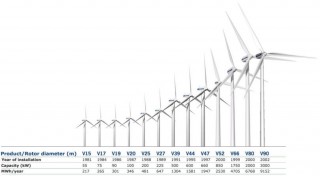 Wind turbines grew immensely; maybe not quite by Moore’s Law, but exceedingly fast for mechanical machinery. So to even compare old turbines to new is exactly like comparing your old Commodore 64 to a current computer: that’s to say, not even wrong.
Wind turbines grew immensely; maybe not quite by Moore’s Law, but exceedingly fast for mechanical machinery. So to even compare old turbines to new is exactly like comparing your old Commodore 64 to a current computer: that’s to say, not even wrong.
This is how wind turbine hub height grows by installation year for the sites it can be reliably extracted from the REF data:
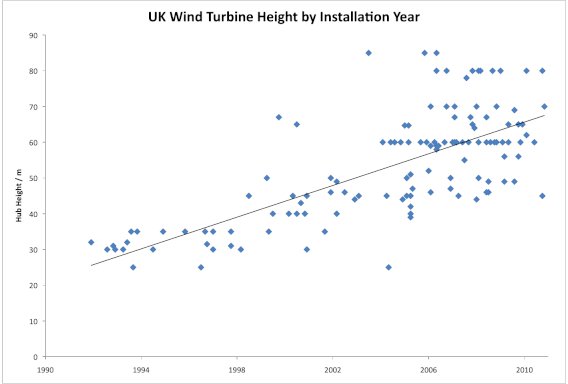 or if you want to look at it the way REF does, by age:
or if you want to look at it the way REF does, by age:
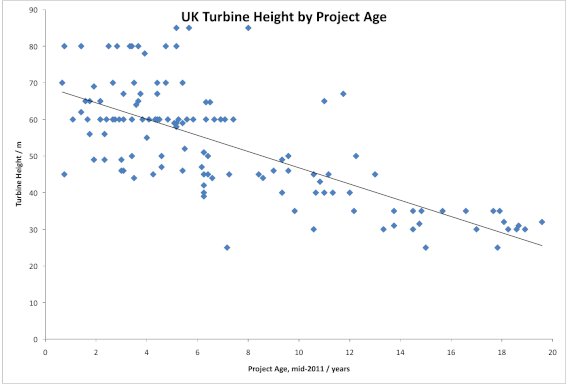 (I fully expect someone to come out with a report that says “Wind Turbines Get Smaller As They Get Older” … oh wait, REF already did.)
(I fully expect someone to come out with a report that says “Wind Turbines Get Smaller As They Get Older” … oh wait, REF already did.)
To compound this effect, wind speeds increase with height from the ground. So taller, newer turbines are able to harvest much more energy than shorter, older ones. What’s more, the larger a wind turbine’s rotor, the more swept area it has, so it will have even more energy available to supply to the grid. In a later post, I’ll run a simulation where, with no degradation from a wind turbine’s output, you can fake a decline just by building taller turbines every year.
In short, we can take two things from the anti-wind REF’s report:
- There is no gross decline in a wind project’s output with age.
- New, tall turbines are super-awesome compared to older, shorter ones.
The sad thing is that REF peddle this deliberately misleading crap, and some of the public believes them. The spectacularly sad thing is that I had to waste my time sleuthing my way through it all.
Nice crane
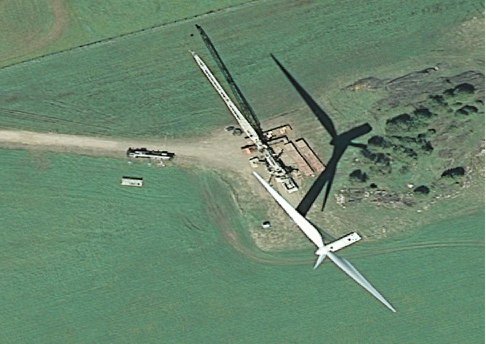 Looks like one of the Ferndale turbines was under maintenance when the USGS flew its orthophotos …
Looks like one of the Ferndale turbines was under maintenance when the USGS flew its orthophotos …
wind and solar … with heavy tree cover
As seen in Birkdale Ravine: wind and solar powered LED lighting in an area with heavy tree shading. Not just any wind turbines, VAWTs, no less. In the words of Modern Toss’s Drive by Abuser, “How’s that working out for you, yeah?”
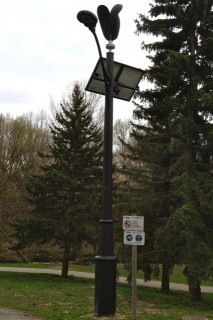
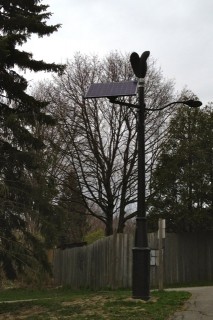
Colorado
“woohoo, we’re #5!!!”
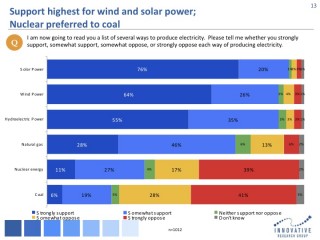 Poor nuclear power just can’t catch a break. The Canadian Nuclear Association commissioned a cross-Canada attitude survey, and — well, I guess people like nuclear power slightly more than coal, but worse than everything else. Which sucks to be nuclear, I suppose.
Poor nuclear power just can’t catch a break. The Canadian Nuclear Association commissioned a cross-Canada attitude survey, and — well, I guess people like nuclear power slightly more than coal, but worse than everything else. Which sucks to be nuclear, I suppose.
“Environmental Impacts of Wind-Energy Projects” now free download
vawt’s up with durham college?
And for once, most of them were working:
![vawts up with durham college? [ho ho ho]](http://scruss.com/wordpress/wp-content/uploads/2011/04/xIMG00071-20110402-1443.jpg) as seen at Durham College.
as seen at Durham College.
ExPlace Turbine Shutdown for Service
I noticed this in my twitter feed the other day:
windshare: ExPlace Turbine Shutdown for Service http://wp.me/p11wfW-8T
From what the linked news release said, it looks like the turbine has had a major mechanical component failure. The replacement part will take several months to arrive, then needs a crane to replace it. The turbine is structurally sound, and is even yawing to follow the wind, but can’t generate.
This is a shame, as the volunteers at WindShare had just got the turbine operating at very close to commercial availability. There are also a couple of usefully windy months before the summer for which co-op members will lose revenue.
Update: a very watered-down news release went up on April 3rd: Turbine Technology Update.
Why I didn’t vote for George Smitherman
I didn’t vote for George Smitherman because I fundamentally disagree with the secret deal he initiated with the Korean consortium (including Samsung and Kepco). A feed-in tariff is all about equal access to the right to connect. The consortium, with its guaranteed grid capacity, sidesteps this equal access.
To make things worse, the consortium may have access to a price adder on top of the FiT prices. This is supposed to recognize the consortium’s expertise in the supply chain, and its consequential creation of jobs through local manufacturing. There are many other companies — some of which actually have supply chain experience in the renewable energy sector — who would bring the same number of jobs for the same number of megawatts.
So, ixnay on the Ithermansmay for that. There’s no way I’d vote for the glistening oaf (a phrase coined by Catherine after seeing this picture), so Joe Pantalone it was. Joey Pants’ campaign was, well, a bit pants, but he was the most appropriate of the candidates.
Steve Ellis’ Air-Trike
My comments on the “Renewable Energy Approval Requirements for Off-shore Wind Facilities”
Dear Mr Duffey
EBR Registry Number: 011-0089
Renewable Energy Approval Requirements for Off-shore Wind Facilities – An Overview of the Proposed Approach
I would like to propose that the mandatory 5km shoreline exclusion be removed entirely, for the following reasons:
1 Drinking Water Source Setbacks
While the “Technical Rules: Assessment Reportâ€1 of the Clean Water Act 2006 is cited as a major reason for the 5km shoreline setback, the assessment report itself provides for no greater setback than 1000m from a water intake in a Great Lake. It is suggested that this one kilometre setback be maintained for existing and planned intakes, but should not be applied as a blanket distance for all development. To force a larger setback than the Act allows is to discriminate against wind energy and the industry.
2 Lake Bathymetry
Taking the particular case of Lake Ontario near Toronto, the water depth at 5km from shore is typically2 40-70m. This is far greater than is practical, and would require massive and costly foundations.
3 Noise
The proposed shoreline exclusion unscientifically precludes any project coming closer to shore. As your document states that noise guidelines for offshore projects are in development, setbacks derived from these guidelines should be allowed. The document should also clarify that the 5km shoreline exclusion is typically larger than the setback required by the Noise Guidelines for Wind Farms3, as at a recent MOE session on Low Frequency Noise Measurement4, representatives of “The Society for Wind Vigilance†stated that 5km was now the setback recommended by the MOE for all wind projects.
4 Positive Visual Enhancement
Wind energy is the most visual form of electrical generation, and it is a subjective matter as to whether the turbines are ugly or beautiful. The major shoreline constraint cited by the Ohio Department of Natural Resources is due to “aesthetic hindranceâ€5, yet the Great Lakes Wind Energy Center’s Final Feasibility Report6 wishes to site their pilot turbine as close to shore for “the highest iconic valueâ€. Copenhagen, the capital city of Denmark, has an arc of wind turbines in the bay approximately 3km from the shore, and less than 5km from the Amalienborg Palace. By placing these turbines close to the city, they have made a statement of their commitment to sustainability, and avoided rows of pylons, which few (if any) could call anything but ugly.
I would hope that you would take my comments into account.
Yours sincerely,
Stewart C. Russell, P.Eng.
References:
4 12th August – 2300 Yonge St – 9:30-11:30am.
Offshore Wind: much of Copenhagen is within 5km of offshore wind turbines
There’s a bit of a stooshie going on in Ontario renewables circles about a proposed 5km minimum shoreline setback for offshore wind turbines in the Great Lakes. This pretty much kills most projects through infrastructure costs — deep lake foundations are expensive, as is submarine cable. Please express your opposition.
I’ve flown over Middelgrunden, and found it to be an icon in Copenhagen’s harbour. With some freehand tracing in Google Earth and some minor GIS skills (hey, I’m learning), here’s how much of Copenhagen is within 5km of the turbines:
That looks like quite a lot; lots of homes and tourist attractions, and not just the harbour. If you want a closer look, here’s the buffer in KML format: Middelgrunden-5km.kml.
I’m trying to find the location of the turbine 500m from shore at Hooksiel, but maybe it’s a bit new for Google Earth imagery. Fixed that for me:

File: BARD Hooksiel 5km buffer.kml
worst. turbine. sheltering. EVAR!!
Walking on the Town of Kansas bridge, I saw this:
Its purpose appeared to rotate the white plastic barrels, which were mounted on eccentric and squeaky bearings. The little wind turbines are stuck right behind the solar panels, so they get little, if any, wind.
The Windmill Farmer
YouTube – The Answer – Paul Kaplan
Wind Turbine Syndrome: Myths and Facts Webinar | Windustry
This is good: Wind Turbine Syndrome: Myths and Facts Webinar.

